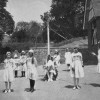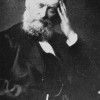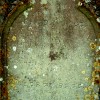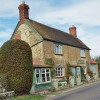The parish of Stoke Wake is no more. Its church is redundant, pensioned off to a life as a farm store, its cottages and farms thinly spread over little more than a thousand acres incorporated, not so many years ago, into the neighbouring parish of Hazelbury Bryan.
On the brighter side the effort of a climb up Bulbarrow Hill to Rawlsbury Camp will be rewarded with magnificent views. “Surpassing imagination” is how John Hutchins described the vista from the summit of this Celtic encampment, one of the highest points in the County. From here on a day when the skies are clear you will see Shaftesbury some 15 miles to the north; peer south and you will pick out the monument to Thomas Masterman Hardy at Portesham and, beyond that, the English Channel shimmering in the sunlight.
We must go back beyond 1086 and the Conqueror’s ledgers to find the origin of the name of this ancient place. In The Domesday Book it appears as Stocke, possibly a derivation of the Old English word stoc, which is a reference to an outlying settlement or farm. Looking around this wooded landscape we might agree with John Hutchins’ suggestion that ‘Stoke’ is a derivation of the Saxon word stocce, which means wood or stock.
The first reference to ‘Stocke’ is relayed to us in Thomas Gerard’s work written early in the 17th century and known as Coker’s Survey of Dorsetshire (See our article about Thomas Gerard.) “In A.D. 941 King Edmund, King of Wessex, gave to Eddric, his vassal and friend, two manors in Stoke to him and his heirs forever.” At some later time these manors seem to have been given or sold to the Abbess of Shaftesbury as, according to the Domesday Book, “The Church of St. Mary of Sceptesberie held Stocke.”
The Abbess of Shaftesbury’s first tenant lords were the Cusins or Cosyns and the manor was known as Stoke Cosyn until the 13th century. We know that in 1227 John Wake held the manor. In his book, written around 1625, Thomas Gerard records: “The river passing Hollwell, leaveth on the hill over it Wakes Court, now a ruinate place, but antientlie the seat of the noble family of Wakes branched from Lord Wake of Lydell and from who a fair inheritance descended to John Caybes, Hugh Titell and John Mitchell, who married the daughters and heirs of John Wake.” No trace remains of the two dwellings but the Wakes were very rich and we might expect them to have lived in some grandeur, their homes enclosed by some 200 acres of parkland.
Indeed in 1485 Henry VII referred to the Wake manors as Stoke Park but by then they had passed to a Somerset family, the Keynes of Compton Pauncefort, although the place continued to be known as Stoke Wake. The Keynes arrived in 1416 and departed two centuries later in 1614, when the Seymour and Pitt families bought them. The Seymour family bought out the Pitt family and continued to hold the manor into the 19th century.
John Hutchins tells of an ancient church here and there is a record from 1305 that shows a John Wake as patron of that church. Hutchins in 1770 describes a church here built in 1540: “Small late Perpendicular fabric, dedicated to All Saints. It consists of a nave and chancel, a south porch and embattled tower containing four bells, one dated 1626…Over the west door with two scrolls – nearly illegible – are the initials of Robert Childe, Rector 1545. Against the north pillar was painted a beggar and under him the words “He that loveth pleasure shall be a poor man,” The font and shaft are octagonal, of good Perpendicular type, with carved panels. In the north aisle are some curious fragments of stained glass, design, chalice wafer and cross. In 1542 Richard More by his will ordered his body to be buried in the new aisle here.”
Two churches gone and another, All Saints, arose on the same site in 1872. It was designed by G. R. Crickmay with, we are told, a little help from Thomas Hardy. Built at a cost of £900, the four bells from the earlier church were sold to help meet the cost. Being in private hands it is no longer freely accessible so we turn to Pevsner for a brief description: “nave, chancel with apse and a north aisle with a three-bay arcade.” It is built of squared rubble with a red tiled roof with a western bell turret housing just one bell to summon the dwindling congregation, which in the end led to its demise and redundancy.
Near the church, too the north is the Old Rectory described by John Hutchins’ editors as “a commodious and substantial house.” Built by Revd. Thomas Wickham Birch, Rector of Stoke Wake from 1817 to 1872. To the south of the church is The Manor House built in the 18th century. In 1817 the patron was H Seymour Esq. and the living was a rectory in the archdeaconry of Dorset and diocese of Bristol rated in the king’s books at £8. 8. 9d.
To recap, Stoke Wake is a redundant church and parish, its remaining cottages and farms too scattered to be recognised as a village or even a hamlet. A traveller could pass through it and never know its name.



